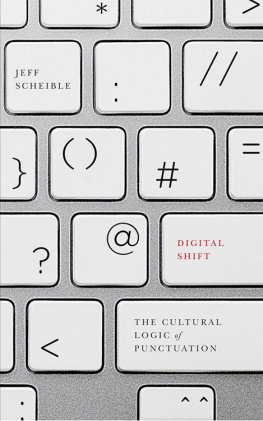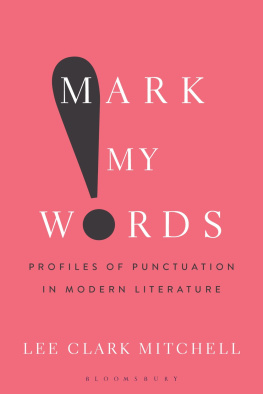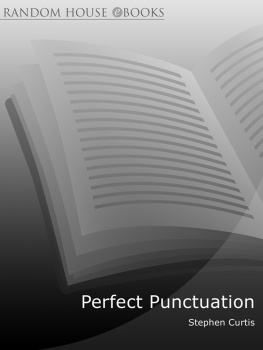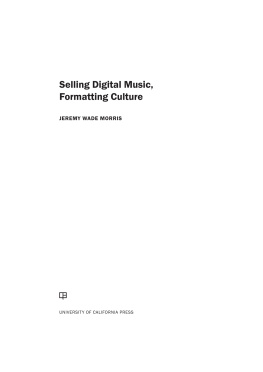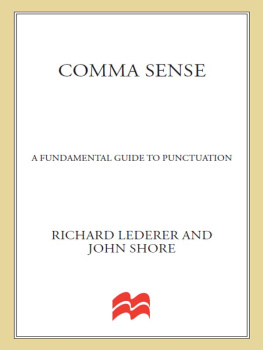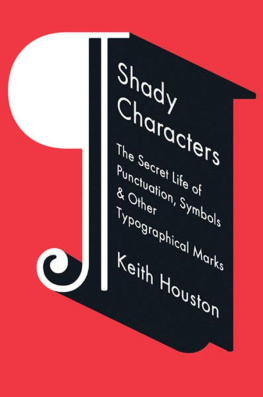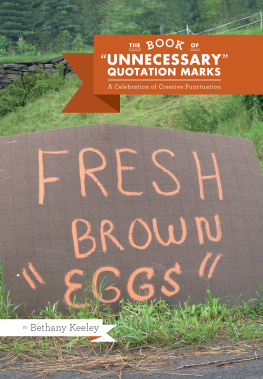A version of chapter 2 was previously published as Within, Aside, and Too Much: On Parentheticality across Media, American Literature 85, no. 4 (Winter 2013): 689717, copyright 2013, republished by permission of the publisher, Duke University Press, www.dukeupress.edu. A portion of chapter 3 originally appeared in Longing to Connect: Cinemas Year of OS Romance, Film Quarterly 68, no. 1 (Fall 2014): 2231, copyright 2014 by The Regents of the University of California; all rights reserved.
All rights reserved. No part of this publication may be reproduced, stored in a retrieval system, or transmitted, in any form or by any means, electronic, mechanical, photocopying, recording, or otherwise, without the prior written permission of the publisher.
Scheible, Jeff.
Digital shift : the cultural logic of punctuation / Jeff Scheible.
Includes bibliographical references and index.
1. Mass mediaTechnological innovations. 2. Mass mediaSocial aspects. 3. Mass media and culture. I. Title.
The University of Minnesota is an equal-opportunity educator and employer.
One of the more exciting aspects of writing this book is that it prompted many people who heard about it to send resources, ideas, and anecdotes related to punctuation from popular culture to media theory my way. Research and writing have in this sense felt rewardingly collaborative. I am indebted to the many friends, colleagues, and mentors I was privileged to meet at UC Santa Barbara. Edward Branigan, Nicole Starosielski, and Dan Reynolds have generously given their time and thought to read drafts of this manuscript and offer incisive, inspiring feedback. Constance Penley, Janet Walker, and Alan Liu have been smart, challenging, and supportive readers of my work, too. Other friends, readers, and teachers who have helped shape this project include Joshua Neves, Bishnupriya Ghosh, Bhaskar Sarkar, Lisa Parks, Peter Bloom, Charles Wolfe, Regina Longo, Megan Fernandes, Rita Raley, Allison Schifani, Kevin Kearney, Athena Tan, Meredith Bak, Chris Dzialo, Rahul Mukherjee, Maria Corrigan, Anastasia Hill, and Hye Jean Chung.
My interest in punctuation emerged during my years working as a copy editor, then managing editor, of Camera Obscura. My rotating tasks included printing drafts of articles, marking them up with grammatical and spelling corrections, and writing editorial inquiries to authors. The marks I made often used punctuation as shorthand, suggesting ways in which these typographical symbols are semiotic codes we use to facilitate communication and consolidate complex commands. On other occasions my marks more literally corrected punctuation usages adding em dashes where authors did not know they belonged, inserting parenthetical page references, shortening sentences by substituting semicolons with periods, and so on. I developed a sensitivity to the topic of punctuation by working with writing on such a detail-oriented level. It is natural to overlook punctuation, but the more time I spent editing, the more I became intrigued by the ways it structures our thought and can open out onto thinking about not only language but about history, habits, personalities, style, visual culture, graphic design, rules, and, perhaps most appealing to me, breaking rules. I worked closely with many people I admire while there: Constance Penley, Patricia White, Amelie Hastie, Lynne Joyrich, Sharon Willis, Andrea Fontenot, Athena Tan, and Ryan Bowles.
A wider community of colleagues and audiences has given feedback to drafts of chapters and conference presentations that has directly and indirectly worked its way into the following pages. Thanks to Wendy Chun, Patricia White, James Hodge, Zach Meltzer, Brian Jacobson, and engaged audiences at UCSB, Concordia University, SUNY Purchase, University of Aberdeen, University of Chicago, SCMS meetings in Seattle and New Orleans, and the Visible Evidence XX Conference in Stockholm. Thanks also to Mara Mills for putting me in touch with George Kupczak from the AT&T Archives and to George for sharing Bell Labs documents with me. My relatively speedy completion of this manuscript would not have been possible without a generous Banting Postdoctoral Fellowship that granted me research time in Concordia Universitys Mel Hoppenheim School of Cinema, which Martin Lefebvre and Haidee Wasson were instrumental in helping me secure. While there, Juan Llamas-Rodriguez offered excellent research assistance in final stages. My writing in Montreal was bolstered by a new community of scholars and friends, including Tom Waugh, Marc Steinberg, Yuriko Furuhata, Michelle Cho, Luca Caminati, Masha Salazkina, and Katie Russell. Jocelyn Braddock, Matt Kaelin, Marc Boucai, Amy Robinson, the Blocks, Mathieu Leroux, and Sally Heller have offered perspective, stimulation, distractions, and care when they were needed.
It has been a pleasure to work with University of Minnesota Press, and I of course am also indebted to Danielle Kasprzak and the anonymous readers for the Press, who offered valuable feedback.
Textual Shift and the Cultural Logic of Punctuation
The Equal Sign Takes Over Facebook
Every day in 2013, over a million Facebook users in the United States updated their profile pictures. On March 26, 2013, however, 2.7 million (120 percent) more users than usual changed them. The overwhelming majority of the new images that accounted for this spike were variations of the same basic design: a pink equal sign on a red backdrop. This trend was due to the Human Rights Campaigns (HRCs) newly colored logo (now red and pink rather than their previous blue-and-yellow equal sign) to support marriage equality for homosexual Americans in the context of the Supreme Courts hearing cases that week regarding Californias Proposition 8 and the Defense of Marriage Act, legislation that denied rights to gays in the United States. This swarm of pink-and-red pictures of symbols in squares represents a distinctly digital form of media activism whose usefulness and meanings are probably less obvious and more complicated than we might think at first. Like all popular Internet phenomena, this image generated a wave of responses and variations: from a pink greater than sign replacing the equal sign as a queer critique of heteronormativity by the activist organization Against Equality to an image of televisions Southern cooking icon Paula Deen edited sitting atop the image, with text reading Its like two sticks of butter, yall. Nearly all popular news websites in the week following the phenomenon compiled slide shows of their favorite variations.
Texts, as humanists know, exist in contexts. What might we discern about the context of this visual text, a pink equal sign in a red square, that millions of people adopted as their online avatar? How do we understand the significance of its politics? How does it relate to the Supreme Court hearings that occurred in conjunction with it? What picture does this image of the equal sign paint of American media and society in our digital twenty-first century? In what set of conditions does it make sense as a cultural phenomenon?

